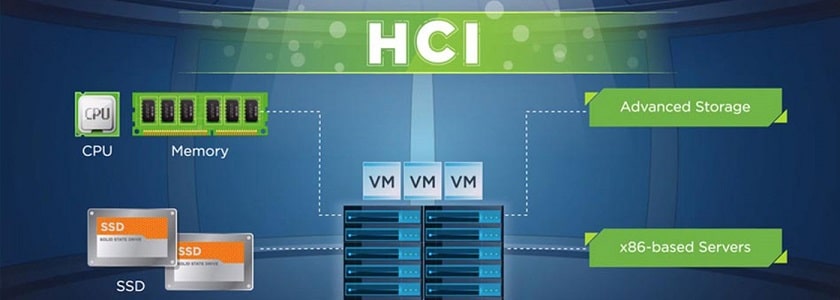Why should you Monitor the Hyperconvergence System?

TechsPlace | A software-defined unified system, HCI (hyper-converged infrastructure) hyperconvergence systems are the top choice of organizations that want to move away from legacy systems but are not ready to deal with the challenges that cloud infrastructure brings.
And if your organization is also moving to the HCI systems, it is worthwhile to know why the admin should monitor these systems. Scroll down to find the reasons to monitor the HCI systems. But before that, let’s understand the benefits of using hyper converged infrastructure software.
HCI and Its Benefits
HCI, otherwise known as hyperconvergence systems, are suitable for organizations that want to move away from three-tier data centre architecture. Meanwhile, these organizations see future growth before choosing these systems.
One of the benefits of HCI is they are scalable. For instance, admins can add nodes and improve performance to increase workloads. However, if you do not see advanced growth in the near future — or the need for it — your organizations should opt for converged systems instead.
Reasons To Monitor HCI Systems
As mentioned, the software, hardware, and visualizations interface are connected in the HCI system. Moreover, there are also other aspects attached to it. For instance, your organization might integrate these systems with third-party tools and the organizational IT infrastructure. Needless to say, coherent monitoring is critical to ensure that none of the processes interlinked with the HCI systems gets interrupted.
That said, read on to find some HCI management tips.
HCI Management Tips
HCI systems are self-contained systems that can deal with numerous vulnerabilities. Moreover, these systems are so designed that all the data remains safe even if one happens to fail. Yes, the underlying software ensures to contain the damages and not spread them over to other building blocks.
Nevertheless, most often — organizations integrate these systems with third-party tools and IT infrastructure. And these systems require managing to address specific aspects related to integrating third-party tools and systems.
1. Predetermined the Specific Use Case of HCI Systems
One of the major problems that organizations have faced with the HCI systems is inflexibility. Yes, by definition, HCI systems are designed to be flexible. In fact, they can deal with numerous organisations’ workloads without any issues. However, the reason most organizations have faced issues with the HCI system is that they try to run high-performance applications with HCI systems which often results in inflexibility.
So, it is better to predetermine the specific use cases of the HCI systems — like virtual desktop infrastructure needs — and determine the nodes based on that. Of course, this does not mean that you have to count all use cases beforehand and work on the nodes attached to the system accordingly. Instead, whenever — even at a later phase after implementing the system — there is a need to bring high-performing applications, it is better to predetermine the use cases beforehand and add nodes accordingly.
2. Disaster Recovery Plan
Another aspect that organizations often neglect after implementing HCI systems is planning for disaster recovery. The thing about HCI systems is they can be used as disaster recovery systems in case virtual machines fail. Moreover, most admins’ staff might already know the processes related to using HCI as a disaster recovery system because of the nature of the software. For context — almost all the backup vendor supports visualization-based backup at some level. And the thing is some organizations do understand this aspect of the HCI systems. Still, most organizations fail to utilize the HCI software as a disaster recovery system. And this is more prevalent in small to midsize businesses. As a result, these SMBs spend additional — and unnecessary — money on backups. So, if your organization is investing unnecessary funds in backups, it is high time to consider this solution. You can manage this aspect of the HCI system and create a reliable disaster recovery solution with your existing HCI system.
3. Bring Down to Complexity of the IT Infrastructure with Hyper-convergence
With the advancement in IT technologies, the IT infrastructure is becoming more complex and diverse. This diversity and complexity are not only hard to manage, but also create unnecessary silos.
Not to mention, these problems create other challenges like reducing organizations’ productivity and increasing the gap between two departments. However, the unified nature of the HCI systems allows the organizations to create a single visualization interface for every department, making it simple to access cross-department data and avoid functional silos.
4. Focus on Improving Organization-Wide and Cross-Departmental Processes with HCI
To emphasize the above point, the unified nature of the HCI solution allows the organization and department to integrate all the third-party apps, data, and other processes with these systems easily. So, when bringing these solutions, it is better to bring on consultants who can help you integrate with all the processes and create a seamless visualization interface for every department that allows them to work conveniently without creating any silos.
Conclusion
Whenever an organization is introduced with new processes and implementation, there are technical changes, process changes, as well as people changes (educating the staff). And when it comes to the HCI implementation, organizations did not face many technical changes. And for apparent reasons, most of them sought outside help. However, when it comes to organizational and people changes, most organizations say they are still working on improving these processes. So, focus on educating the departments in advance and inform them about the changes that HCI implementation will bring, while working on creating a unified system that can integrate all aspects of every department and avoid functional silos.
This article is contributed by guest author on techsplace.com.





